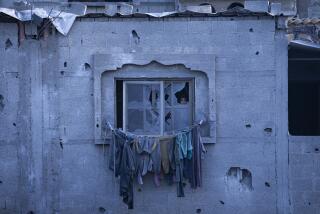A Grim Stroll to Borough of Hades
- Share via
NEW YORK — Block by block, the descent by foot into lower Manhattan is a trip from seemingly normal city life into a disordered world.
Houston Street: Twenty blocks north of New York’s new ground zero, the site where the World Trade Center stood, shoppers still lug bulging bags from Pottery Barn and Ann Taylor Loft. But the stores are too quiet.
Pronounced “How-stun,” this is the northern boundary of lower Manhattan, gateway to cafes and boutiques too hip and too pricey for the students who colonize Greenwich Village.
Here, New York seems almost New York. Except sidewalk vendors are hawking American flags and red, white and blue T-shirts instead of the usual knockoff watches.
Walk a few blocks south and the sense of emergency sets in.
Canal Street: Fifteen blocks away now, this crooked, bustling thoroughfare running across Manhattan from the Holland Tunnel in the west to the Manhattan Bridge in the east has become a new boundary. Steel police barricades block off southbound streets to vehicles. Police turn away drivers without government ID.
South of here, the city’s ever-present traffic roar fades.
Someone has hung a bedsheet spray-painted with the message, “Rescue Workers, We (Heart) You.”
Paper flags plaster store windows like SALE signs. Some face in, looking disturbingly backward from the street.
A missing poster pleads for information on Michael Tanner, a Cantor Fitzgerald employee from the 104th floor. His black-and-white smile beams over the shoulder of the baby on his lap. Michael is 44, the flier says. “Pleaseeeee call.”
Worth Street: The stench, reminiscent of burning rubber, is stronger here, just 10 blocks away now.
Phone company trucks are everywhere. Each one flies an American flag from its radio antenna.
The glass doors of the Federal Building are barricaded, with a mobile police command center set up in an RV outside.
A woman holds a scarf to her face. Grit stings the throat. Haze dims the sun.
Chambers Street: Five blocks from the wreckage, police at barricades herd pedestrians eastward. Streets running toward the World Trade Center are shut down. This was open last night, someone says. It’s closed now.
Police are on every corner, some with small red, white and blue ribbons pinned over bulletproof vests.
Subway-seeking commuters stream toward the Municipal Building, where prospective brides and grooms once went for quickie weddings. All such ceremonies are on hold there.
In front of a barricaded City Hall, clean-cut men hand out leaflets containing a “Prayer for America.” A vendor peddles more red, white and blue ribbons pinned together with tiny American flags.
A brown cloud hovers over the wasteland blocks away, glimpsed from between buildings.
A boy, 5 or 6, wears a paper surgical mask. So does the security guard at Pace University. Police leaving City Hall strap small gas masks to their belts. The slightest wind whips up a cloud of choking dust.
Police vans, full of half-giddy officers finishing 15-hour shifts, idle outside a Starbucks open only to emergency workers. A flier advertises the Red Cross’ phone number.
The first of hundreds of National Guardsmen watch over an intersection. Steel gates shutter Music World and Holtzman Hardware. A sign promises they will reopen soon.
Broadway and Ann Street: As close as you can get to ground zero, where the twin towers should block the setting sun, a wide slice of clear blue sky appears.
Utility trucks and ambulances idle, double-parked, bumper-to-bumper. Twenty portable toilets line the sidewalk behind Trinity Church. An army of emergency workers swarms over the area.
Green signs shout “WARNING: No cameras or video equipment permitted! VIOLATORS will be prosecuted and equipment seized.”
Billy Graham’s New York hotline number peeks out from beneath another poster of a missing person. “Need a Prayer?” it asks.
A steady flow of volunteers, firefighters, environmental consultants and construction workers navigates around blue wooden police barriers to the sidewalk just outside the restricted zone. They leave behind what one calls “total, utter annihilation.”
Au Bon Pain is open, serving its standard chocolate croissants and cafe au lait. A stranger looks straight at another and smiles. That never used to happen in New York.
More to Read
Sign up for Essential California
The most important California stories and recommendations in your inbox every morning.
You may occasionally receive promotional content from the Los Angeles Times.













